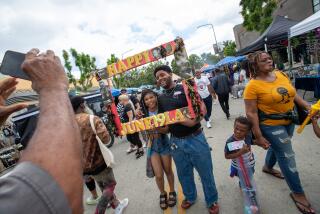Simi Festival Organizers Look to Cut Costs
- Share via
SIMI VALLEY — The organizers of Simi Valley Days are facing a grim realization this year: They won’t be able to live on Kowchip Bingo and Mutton-Busting alone.
Because the popular rodeo and western festival ended nearly $10,000 in the hole last autumn, organizers have begun laying plans to bring in more money to meet their rising bills.
And they want to make it plain that the fair raises thousands of dollars--including more than $60,000 last year--for charities that help the city’s youth, senior citizens, schools, parks, the homeless, teachers and police, among other beneficiaries.
“We have a number of old-timers here--or shall we say longtime residents--who for some reason or another are unaware of Simi Valley Days as a community event,” said Ed Levine, vice president of the Simi Valley Days Organization Inc..
“By bringing to light the benevolence of what this is for the community, we hope we’ll raise the consciousness and capture the 70,000 . . . people in our community that DON’T participate,” he said.
The fair’s new hillside site at the north end of 1st Street must be leveled to make way for parking and heavy rides. Earthmovers and engineers cost money that the fair does not have, Levine said.
Simi Valley Days also faces the rising cost of doing business--the rodeo fees, portable toilet rentals and other mechanics of showing more than 20,000 people a good, old-fashioned time.
So, fair organizers say they plan to sell T-shirts and caps, go begging for corporate gifts and do whatever they must to convey the message that the festival is a vital fund-raiser for Simi Valley charities, as well as a hoot and a holler.
Until last year, the 13-year-old festival was operating in the black--with an average $2,702 profit since 1993 after paying for the rodeo, site grading, fences, portable toilets and other operating costs, Levine said.
But the 1996 festival year ended with $9,791.81 in extra expenses, due to the increased cost of clearing weeds from the fairgrounds and a drop in ticket sales, Levine said.
The fairgrounds at the old Los Angeles Avenue site--which Simi Valley Days must vacate because of planned housing developments--welcomed only 20,972 visitors last October, down from the 1995 gate count of 22,151, he said.
This year, fair organizers are stumping for corporate sponsorship, donations of goods and services and other fund-raising efforts to pay for preparing the new site. The new 33-acre fairgrounds, which lies on the hilly western end of Simi Valley’s proposed mall site, must be graded and hooked up to city water and power supplies, but Levine says he is confident financial help will be forthcoming.
“All you’ve got to do is ask. It’s real easy,” Levine said. “If you think you can or you think you can’t, you’re right. We think we can, and evidence to that effect comes in daily.”
When problems with a site engineer sent the organizers hunting for a replacement, another local firm stepped up and added the fairground surveying to its busy project list, he said.
And a local union for heavy-equipment operators is considering shoving 100,000 cubic yards of dirt around the site to flatten it out free of charge, Levine said.
The city is already loaning the site gratis, and city dollars have paid for extra police during festivals in the past, said Mayor Greg Stratton.
And if organizers can’t get it done for free, the city might also shoulder the earthmoving costs if it comes to that, he said.
“We could move that dirt. It’s dirt that’s got to be moved eventually, for the mall and the continuation of 1st Street,” he said.
“Obviously, there’s some work to be done,” Stratton added. “And our goal is to try and keep the cost off the taxpayers, and I think the committee has recognized this desire and is trying to keep it as cheap as possible.”
More to Read
Sign up for Essential California
The most important California stories and recommendations in your inbox every morning.
You may occasionally receive promotional content from the Los Angeles Times.













